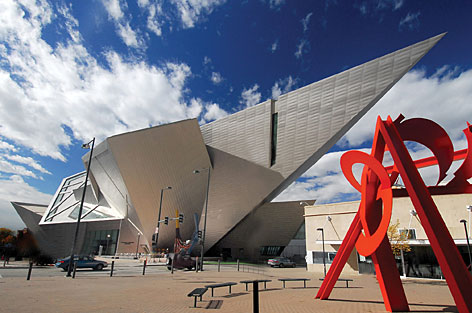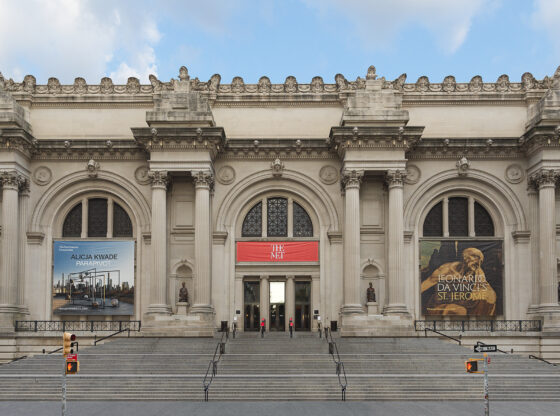Colossal modern paintings grace the walls of a special exhibition at the Denver Art Museum (DAM), like one of Jackson Pollock’s most famed drip paintings, entitled “Convergence,” a swirling mass of shades of orange, blue and striking black. This painting is almost overwhelming to the viewer, but the drips of paint flow and swirl seamlessly through the gigantic canvas, roughly 95 inches tall and 157 inches wide. According to the Albright-Knox Art Gallery website, this piece evokes Pollock’s dissatisfaction with traditional art and his struggles to express himself through it. According to the Albright-Knox website, Pollock explained his deviation from tradition as follows.
“It seems to me that the modern painter cannot express his age, the airplane, the atom bomb, the radio, in the old forms of the Renaissance or any other past culture. Each age finds its own technique.”
From March 2 to June 8, “Modern Masters: 20th Century Icons from the Albright-Knox Art Gallery,” is on display at the DAM. As acknowledged by the DAM website, these pieces are from one of the nation’s the most respected collections of twentieth-century.
According to the DAM website, the exhibition is curated by Dean Sobel, director of the Clyfford Still Museum across the street. Modern Masters is a collection of 68 artworks by over 40 influential artists including Pollock, Frida Kahlo, Georgia O’Keefe and Salvadore Dalí from artistic movements spanning the century. According to the DAM website, the exhibition displays Post-Impressionist works from the late 1800s, as well as Cubist, surrealist, pop art and minimalist works of art.
Upon entering the gallery, a quote by French realist painter William-Adolphe Bouguereau met viewers, setting the stage for the modern exhibition.
“A new art. But what for? We do the best we can, and when we do as well as our masters that’s all we can hope for,” the quote reads.
Around the corner is a Futurist oil painting by Giacomo Balla, “Dinamismo di un cane al guinzaglio,” or “Dynamism of a Dog on a Leash” from 1912. According to the Tate Museum website, futurism was an artistic movement launched by the Italian poet Filippo Marinetti in 1909, its members radical Italian artists who rejected the old and embraced technology, speed and violence in their art. According to the Albright-Knox Art Gallery website, the dynamism advocated by the futurists is reflected in both the title and the composition, in which every detail works toward the ultimate goal of representing motion. The viewer’s eyes frantically try to follow the hectic movement of the dog and the woman in the painting. Both figures in the work are buzzing with motion, but only their feet art moving. The result is an almost humorous depiction of the activity of walking the dog.
According the Metropolitan Museum of Art website, less than thirty years later, Dalí further experimented in his art through the movement of surrealism, which began under the influence of the poet André Breton. According to the Metropolitan Museum website, surrealist artists were highly concerned with the subconscious and dreams, influenced by the psychological theories and dream studies of Sigmund Freud and the political ideas of Karl Marx. According to the Albright-Knox Art Gallery website, Dalí considered his paintings to be “hand-painted dream photographs,” recreations of the dream atmosphere— trying to rationalize the dream amidst the distorted sense of objects, time, and space. Dalí’s “The Transparent Simulacrum of the Feigned Mind” from 1938 features a beach with angular cliffs, a bowl, fabric and almost hidden from view, the tilted face of an African-American woman, which evoke this dream-like quality surrealists are known for. This painting has a dreamy quality and ambiguous title which allow each viewer to have a more personal and unique interpretation of it.
According to the Albright-Knox Art Gallery website, pop artist Roy Lichtenstein’s “Head—Red and Yellow” from 1962, a radical shift from Balla and Dalí, is a reinterpretation of a vacation newspaper advertisement in which a smiling woman throws a beach ball. Lichtenstein appropriated just the woman’s head and depicted it using flat, bright colors, the dots seen on her skin replicating the printing industry’s Benday process, developed by Benjamin Day in 1879, according to the Albright-Knox Art Gallery. According to the Encyclopædia Britannica website, The Benday Process utilizes a series of celluloid screens bearing raised images of dot and line patterns.
According to the Roy Lichtenstein Foundation website, the inclusion of this pop artist in the “Modern Masters” gallery was highly important because it elevated his work, which is often criticized for not being “real” art. However, walking into this section of the gallery and being faced with his monumental works was breathtaking. Students that are interested in Marvel Comics, pop art or even just modern art should definitely pay this exhibition a visit. This exhibition is a must-see as it houses over 40 of the most influential modern artists and highly varied works that are guaranteed to please.
“Modern Masters” and all other galleries at the DAM are discounted for college students, costing $16.00, and at the end of the exhibition is a gift shop with everything from art prints to Picasso mugs.











